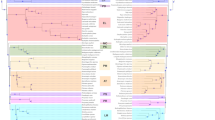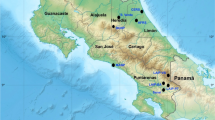Abstract
The sporocysts of the trematode Leucochloridium paradoxum parasitise land snails Succinea putris. The sporocysts form broodsacs whose tegument contains green and brown pigments. The colouration changes during maturation. The pattern and colour of the broodsacs may vary in different individuals and sometimes even in one sporocyst. We studied the broodsacs of 253 sporocysts of L. paradoxum collected in the European part of Russia and Belarus, and identified four main colouration types. An analysis of genetic polymorphism by a fragment (757 bp) of the mitochondrial cox1 gene revealed 22 haplotypes. Using the nucleotide sequences of the cox1 gene fragment of L. paradoxum from Japan and Europe available in GenBank, we constructed haplotype networks. A total of 27 haplotypes were identified. The haplotype diversity of L. paradoxum by this gene was rather low, on the average 0.8320. A low genotypic diversity by the mitochondrial marker is consistent with rDNA conservativeness of Leucochloridium spp. noted previously. The most broadly represented haplotypes, Hap_1 and Нap_3, were described in both sporocysts and adults of L. paradoxum. We suggest that the mobility of birds, which are the definitive hosts of L. paradoxum, provides the necessary conditions for the genotypic diversity of its sporocysts parasitising different populations of snails Succinea putris.










Similar content being viewed by others
Data availability
The datasets generated and/or analysed during the current study are available from the corresponding author on reasonable request.
References
Ataev GL, Babich PS, Tokmakova AS (2013) The study of the sporocyst broodsacs coloring in Leucochloridium paradoxum (Trematoda: Brachylaemidae). Parazitologiya 47:372–379
Ataev GL, Tokmakova AS (2015) Seasonal changes in the biology of Leucochloridium paradoxum (Trematoda, Leucochloridiomorphidae). Parazitologiya 49:200–207
Ataev GL, Zhukova AA, Tokmakova AS, Prokhorova EE (2016) Multiple infection of amber snails Succinea putris with sporocysts of Leucochloridium spp. (Trematoda). Parasitol Res 115:3203–3208. https://doi.org/10.1007/s00436-016-5082-6
Bakke TA (1980) A revision of the family Leucochlorididae Poche (Digenea) and studies on the morphology of Leucochloridium paradoxum Carus, 1835. Syst Parasitol 1:189–202
Blasco-Costa I, Poulin R (2013) Host traits explain the genetic structure of parasites: a meta-analysis. Parasitology 140:1316–1322. https://doi.org/10.1017/S0031182013000784
Bouckaert R, Vaughan TG, Barido-Sottani J, Duchêne S, Fourment M, Gavryushkina A et al (2019) BEAST 2.5: an advanced software platform for Bayesian evolutionary analysis. PLoS Comput Biol 15:1–28. https://doi.org/10.1371/journal.pcbi.1006650
Bowles J, McManus DP (1993) Rapid discrimination of Echinococcus species and strains using a polymerase chain reaction-based RFLPmethod. Mol Biochem Parasitol 57:231–240. https://doi.org/10.1016/0166-6851(93)90199-8
Caius HJ, Little TJ, Ebert D (2001) Genetic variation in a host–parasite association: potential for coevolution and frequency-dependent selection. Evolution 55:1136–1145. https://doi.org/10.1111/j.0014-3820.2001.tb00633.x
Carus C (1835) Beobachtungen über einen merkwürdigen Schӧngefӓrbten Eingeweidewurm Leucochloridium paradoxum mihi und dessen parasitishe Erzeugung in einer Landschnecke Succinea amphibia Drap Helix putris. Nova Acta Leop-Carol 17:85–100
Casey SP, Bakke TA, Harris PD, Cable J (2003) Use of ITS rDNA for discrimination of European green- and brown-banded sporocysts within the genus Leucochloridium Carus, 1835 (Digenea: Leucochloriidae). Syst Parasitol 5:163–168. https://doi.org/10.1023/b:sypa.0000003809.15982.ca
Darriba D, Taboada GL, Doallo R, Posada D (2012) jModelTest 2: more models, new heuristics and parallel computing. Nat Methods 9:772. https://doi.org/10.1038/nmeth.2109
Felsenstein J (1985) Confidence limits on phylogenies: an approach using the bootstrap. Evolution 39:783–791. https://doi.org/10.1111/j.1558-5646.1985.tb00420.x
Ginetsinskaya TA (1953) Significance of the color of sporocysts of trematodes of the genus Leucochloridium for the diagnosis of the species. Doklady USSR Acad Sci 88:177–179
Ginetsinskaya TA (1988) Trematodes, their life cycles, biology and evolution. Amerind Publ Co Pvt Ltd, New Delhi
Gvozdev EV, Soboleva TN (1978) Biology, systematics, evolution and phylogeny of superfamily of trematodes Brachylaimoidea Allison, 1943. In: Gvozdev EV (ed) Life cycles, ecology and morphology of animals in Kazakhstan. Nauka, Almaty, pp 17–31
Hall TA (1999) BioEdit: A user-friendly biological sequence alignment editor and analysis program for Windows 95/98/NT. Nucleic Acids Symp Ser 41:95–98
Heneberg P, Sitko J, Bizos J (2016) Molecular and comparative morphological analysis of central European parasitic flatworms of the superfamily Brachylaimoidea Allison, 1943 (Trematoda: Plagiorchiida). Parasitology 143:455–474. https://doi.org/10.1017/S003118201500181X
Jukes TH, Cantor CR (1969) Evolution of protein molecules. In: Munro HN (ed) Mammalian protein metabolism. Academic Press, New York, pp 21–132
Kagan I (1952) Revision of the subfamily Leucochloridiinae Poche, 1907 (Trematoda, Brachylaemidae). Amer Madland Naturalist 48:257–301
Kimura M (1980) A simple method for estimating evolutionary rate of base substitutions through comparative studies of nucleotide sequences. J Mol Evol 16:111–120. https://doi.org/10.1007/BF01731581
Kumar S, Stecher G, Li M, Knyaz C, Tamura K (2018) MEGA X: molecular evolutionary genetics analysis across computing platforms. Mol Biol Evol 35:1547–1549. https://doi.org/10.1093/molbev/msy096
Leigh JW, Bryant D (2015) PopART: Full-feature software for haplotype network construction. Methods Ecol Evol 6:1110–1116. https://doi.org/10.1111/2041-210X.12410
Leonov VA, Belogurov OI, Tsimbaluk AK, Siichkin ZN (1965) Trematodes of land birds of Kamchatka. In: Oshmarin PG (ed) Parasitic worms of domestic and wild animals. FEB of the USSR Academy of Sciences, Vladivostok, pp 121–129
Lively CM, Dybdahl MF (2000) Parasite adaptation to locally common host genotypes. Nature 405:679–681. https://doi.org/10.1038/35015069
Mitta G, Gourbal B, Grunau C, Knight M, Bridger JM, Théron A (2017) The compatibility between Biomphalaria glabrata snails and Schistosoma mansoni: an increasingly complex puzzle. Adv Parasitol 97:111–145. https://doi.org/10.1016/bs.apar.2016.08.006
Nakao M, Sasaki M, Waki T, Iwaki T, Mori Y, Yanagida K et al (2019) Distribution records of three species of Leucochloridium (Trematoda: Leucochloridiidae) in Japan, with comments on their microtaxonomy and ecology. Parasitol Int 72:101936. https://doi.org/10.1016/j.parint.2019.101936
Pojmanska T (1967) Variability of Leucochloridium paradoxum Carus (= L. heckerti Kagan, 1952) (Trematoda: Brachylaemidae) in natural and experimental conditions. Acta Parasitol Pol 14:381–398
Pojmanska T (2002) Family Leucochloridiidae Poche, 1907. In: Gibson D, Jones A, Bray RA (eds) Keys to the Trematoda, vol 1. CABI Pub. and the Natural History Museum, Wallingford, pp 47–51
Prokhorova EE, Usmanova RR, Ataev GL (2020a) An analysis of morphological and molecular genetic characters for species identification of amber snails Succinea putris (Succineidae). Invert Zool 17:1–17. https://doi.org/10.15298/invertzool.17.1.01
Prokhorova EE, Vinogradova AA, Tokmakova AS, Ataev GL (2020b) The first record of the trematode Urogonimus certhiae (Trematoda: Leucochloridiidae) in the Eurasian nuthatch Sitta europaea. Zoosyst Rossica 29:238–246. https://doi.org/10.31610/zsr/2020.29.2.238
Rozas J, Ferrer-Mata A, Sánchez-DelBarrio JC, Guirao- Rico S, Librado P, Ramos-Onsins SE, Sánchez- Gracia A (2017) DnaSP 6: DNA sequence polymorphism analysis of large data sets. Mol Biol Evol 34:3299–3302. https://doi.org/10.1093/molbev/msx248
Rząd I, Okulewisz A, Sałamatin R, Szenejko M, Panicz R, Nowakowski JK, Stapf A (2023) Helminth community of tits Cyanistes caeruleus and Parus major (Paridae) during their autumn migration on the Southern Baltic Coast. Animals 13:421. https://doi.org/10.3390/ani13030421
Soboleva TN, Osipovskaya LL (1979) Larvae of trematodes of the genus Leucochloridium Carus, 1835 in Kazakhstan. Izvestia Acad Sci KazSSR 1:26–34
Untergasser A, Cutcutache I, Koressaar T, Ye J, Faircloth BC, Remm M, Rozen SG (2012) Primer3--new capabilities and interfaces. Nucleic Acids Res 40:e115. https://doi.org/10.1093/nar/gks596
Usmanova RR, Tokmakova AS, Lopatina OD, Prokhorova EE (2021) Genetic variability of Leucochloridium paradoxum trematodes from the Leningrad region with the use of the mitochondrial cytochrome oxidase subunit 1 (cox1) gene fragment. Parazitologiya 55:355–361. https://doi.org/10.31857/S003118472105001X
Zhukova AA, Prokhorova EE, Tokmakova AS, Tsymbalenko NV, Ataev GL (2014) Identification of species Leucochloridium paradoxum and L. perturbatum (Trematoda) based on rDNA sequences. Parazitologiya 48:185–192
Acknowledgements
The authors are grateful to Natalia Lentsman for her help with the preparation of the English version of the manuscript and Tatiana Bogacheva for her assistance in preparing the scheme of colouration of mature broodsacs of Leucochloridium paradoxum.
Funding
The study was funded by RSF (project no. 22-24-20057).
Author information
Authors and Affiliations
Contributions
GA designed the research; RU, AT and EP substantially participated in conception and improvement of research; EP, RU and NT performed the phylogenetic and haplotyping analysis; AT and RU annotated cox1 gene fragment; AT prepared Figs. 1, 2, 3 and 4; GA led the manuscript writing; all authors contributed to the article and approved the submitted version.
Corresponding author
Ethics declarations
Ethics approval
Not applicable.
Consent to participate
Not applicable.
Consent for publication
All authors agreed to the publication of the manuscript.
Competing interests
The authors declare no competing interests.
Additional information
Handling Editor: David Bruce Conn
Publisher’s note
Springer Nature remains neutral with regard to jurisdictional claims in published maps and institutional affiliations.
Rights and permissions
Springer Nature or its licensor (e.g. a society or other partner) holds exclusive rights to this article under a publishing agreement with the author(s) or other rightsholder(s); author self-archiving of the accepted manuscript version of this article is solely governed by the terms of such publishing agreement and applicable law.
About this article
Cite this article
Usmanova, R.R., Ataev, G.L., Tokmakova, A.S. et al. Genotypic and morphological diversity of trematodes Leucochloridium paradoxum. Parasitol Res 122, 997–1007 (2023). https://doi.org/10.1007/s00436-023-07805-7
Received:
Accepted:
Published:
Issue Date:
DOI: https://doi.org/10.1007/s00436-023-07805-7




